Loss of Asxl1 leads to myelodysplastic syndrome-like disease in mice
- PMID: 24255920
- PMCID: PMC3901067
- DOI: 10.1182/blood-2013-05-500272
Loss of Asxl1 leads to myelodysplastic syndrome-like disease in mice
Abstract
ASXL1 is mutated/deleted with high frequencies in multiple forms of myeloid malignancies, and its alterations are associated with poor prognosis. De novo ASXL1 mutations cause Bohring-Opitz syndrome characterized by multiple congenital malformations. We show that Asxl1 deletion in mice led to developmental abnormalities including dwarfism, anophthalmia, and 80% embryonic lethality. Surviving Asxl1(-/-) mice lived for up to 42 days and developed features of myelodysplastic syndrome (MDS), including dysplastic neutrophils and multiple lineage cytopenia. Asxl1(-/-) mice had a reduced hematopoietic stem cell (HSC) pool, and Asxl1(-/-) HSCs exhibited decreased hematopoietic repopulating capacity, with skewed cell differentiation favoring granulocytic lineage. Asxl1(+/-) mice also developed mild MDS-like disease, which could progress to MDS/myeloproliferative neoplasm, demonstrating a haploinsufficient effect of Asxl1 in the pathogenesis of myeloid malignancies. Asxl1 loss led to an increased apoptosis and mitosis in Lineage(-)c-Kit(+) (Lin(-)c-Kit(+)) cells, consistent with human MDS. Furthermore, Asxl1(-/-) Lin(-)c-Kit(+) cells exhibited decreased global levels of H3K27me3 and H3K4me3 and altered expression of genes regulating apoptosis (Bcl2, Bcl2l12, Bcl2l13). Collectively, we report a novel ASXL1 murine model that recapitulates human myeloid malignancies, implying that Asxl1 functions as a tumor suppressor to maintain hematopoietic cell homeostasis. Future work is necessary to clarify the contribution of microenvironment to the hematopoietic phenotypes observed in the constitutional Asxl1(-/-) mice.
Figures
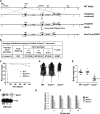
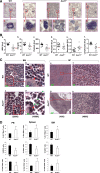
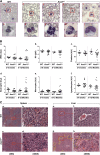

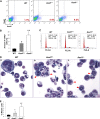

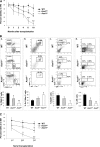

Similar articles
-
Deletion of Asxl1 results in myelodysplasia and severe developmental defects in vivo.J Exp Med. 2013 Nov 18;210(12):2641-59. doi: 10.1084/jem.20131141. Epub 2013 Nov 11. J Exp Med. 2013. PMID: 24218140 Free PMC article.
-
Epigenetic regulation by ASXL1 in myeloid malignancies.Int J Hematol. 2023 Jun;117(6):791-806. doi: 10.1007/s12185-023-03586-y. Epub 2023 Apr 16. Int J Hematol. 2023. PMID: 37062051 Review.
-
The distinct biological implications of Asxl1 mutation and its roles in leukemogenesis revealed by a knock-in mouse model.J Hematol Oncol. 2017 Jul 11;10(1):139. doi: 10.1186/s13045-017-0508-x. J Hematol Oncol. 2017. PMID: 28697759 Free PMC article.
-
[Role of ASXL1 mutations in hematological disorders].Rinsho Ketsueki. 2019;60(6):680-690. doi: 10.11406/rinketsu.60.680. Rinsho Ketsueki. 2019. PMID: 31281161 Japanese.
-
The role of ASXL1 in hematopoiesis and myeloid malignancies.Cell Mol Life Sci. 2019 Jul;76(13):2511-2523. doi: 10.1007/s00018-019-03084-7. Epub 2019 Mar 30. Cell Mol Life Sci. 2019. PMID: 30927018 Free PMC article. Review.
Cited by
-
Loss of Asxl1 Alters Self-Renewal and Cell Fate of Bone Marrow Stromal Cell, Leading to Bohring-Opitz-like Syndrome in Mice.Stem Cell Reports. 2016 Jun 14;6(6):914-925. doi: 10.1016/j.stemcr.2016.04.013. Epub 2016 May 26. Stem Cell Reports. 2016. PMID: 27237378 Free PMC article.
-
Proliferative activity is disturbed in myeloproliferative neoplasms (MPN), myelodysplastic syndrome (MDS), and MDS/MPN diseases. Differences between MDS and MDS/MPN.Cytometry B Clin Cytom. 2021 May;100(3):322-330. doi: 10.1002/cyto.b.21946. Epub 2020 Aug 28. Cytometry B Clin Cytom. 2021. PMID: 32857909 Free PMC article.
-
Modeling clonal hematopoiesis in umbilical cord blood cells by CRISPR/Cas9.Leukemia. 2022 Apr;36(4):1102-1110. doi: 10.1038/s41375-021-01469-x. Epub 2021 Nov 15. Leukemia. 2022. PMID: 34782715 Free PMC article.
-
Combined Loss of Tet1 and Tet2 Promotes B Cell, but Not Myeloid Malignancies, in Mice.Cell Rep. 2015 Nov 24;13(8):1692-704. doi: 10.1016/j.celrep.2015.10.037. Epub 2015 Nov 12. Cell Rep. 2015. PMID: 26586431 Free PMC article.
-
Clonal Hematopoiesis, Cardiovascular Diseases and Hematopoietic Stem Cells.Int J Mol Sci. 2020 Oct 24;21(21):7902. doi: 10.3390/ijms21217902. Int J Mol Sci. 2020. PMID: 33114351 Free PMC article. Review.
References
-
- Fisher CL, Berger J, Randazzo F, Brock HW. A human homolog of Additional sex combs, ADDITIONAL SEX COMBS-LIKE 1, maps to chromosome 20q11. Gene. 2003;306:115–126. - PubMed
-
- LaJeunesse D, Shearn AE. E(z): a polycomb group gene or a trithorax group gene? Development. 1996;122(7):2189–2197. - PubMed
-
- Milne TA, Sinclair DA, Brock HW. The Additional sex combs gene of Drosophila is required for activation and repression of homeotic loci, and interacts specifically with Polycomb and super sex combs. Mol Gen Genet. 1999;261(4-5):753–761. - PubMed
-
- Fisher CL, Randazzo F, Humphries RK, Brock HW. Characterization of Asxl1, a murine homolog of Additional sex combs, and analysis of the Asx-like gene family. Gene. 2006;369:109–118. - PubMed
Publication types
MeSH terms
Substances
Grants and funding
LinkOut - more resources
Full Text Sources
Other Literature Sources
Medical
Molecular Biology Databases
Research Materials
Miscellaneous

